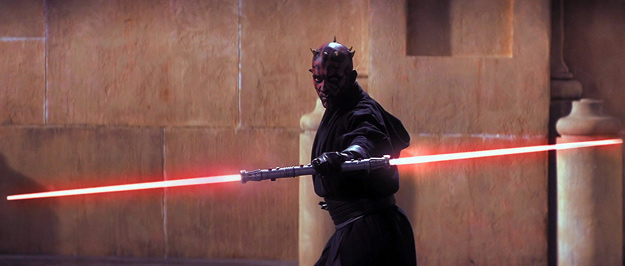
Coate: In what way is The Phantom Menace significant?
Danley: The Phantom Menace is significant in that it pushed boundaries as Star Wars always has, both in terms of visual storytelling and completely dominating popular culture to a degree the world likely hadn’t seen since the original film conquered it in 1977. It established its own iconography that has continued to stand out among all of the Star Wars content that’s followed it. It relied on that striking imagery to express itself (many would argue to a fault). Maul’s devilish look embodied malice. The Queen’s elaborate costumes embodied peace and grace, etc. etc. All the while, this iconography was hilariously inescapable in day-to-day life, from toys to soda cans to pizza boxes to lip balm to office supplies to most disturbingly, Jar Jar Binks tongue lollipops.
Miller: That it was a $100 million-plus movie financed and directed by one man: George Lucas. It’s rare for filmmakers to personally finance their own multi-million-dollar movies on this level, with total creative freedom and control.
Episode I changed the scope of the Star Wars universe, in which Lucas imposed restrictions on his galaxy. Instead of many Sith and many Jedi, we have the “one master, one apprentice” rule. Instead of C-3PO being a mass production model of his type, he is simply built from spare parts. Instead of everyone having the capacity to wield the force, that ability is restricted to those who have an abundance of “midichlorians.” And while having the future Darth Vader be the one who put together Threepio might have amused Lucas, he jettisoned the earlier concept that Threepio was built 112 years before the original Star Wars, that Threepio and Artoo were interstellar vagabonds bouncing from master to master, as depicted in the cartoon Droids: The Adventures of R2-D2 and C-3PO. With the prequels, the Droids generally stayed with Queen Amidala and Anakin Skywalker, eventually winding up with the Organa family.
Originally, Lucas had intended the Droids to be like the bickering peasants in The Hidden Fortress, with the Star Wars saga presented from their point of view. Not so in The Phantom Menace. Lucas shifted the comic relief emphasis from them to Jar Jar Binks.
In Star Wars, he had envisioned Threepio to be like a used car salesman, who actually demonstrated he could be clever. He had a “silver tongue.” To wit: “Excuse me, sir, but that R2 unit is in prime condition. A real bargain.” And, “They’re madmen. They’re heading for the detention area. If you hurry, you might catch them.” And, “All this excitement has overrun the circuits in my counterpart here. If you don’t mind, I’d like to take him down to maintenance.” That aspect of his personality was now gone. He was simply a shell of his former (that is, future) self.
What used to be “The Adventures of Luke Skywalker” had become, with Return of the Jedi, “The Tragedy of Darth Vader,” as the first subtitle was dropped after the novelizations of Star Wars and The Empire Strikes Back. The Phantom Menace began the tragedy.
The biggest paradigm shift was that the saga was no longer a tale of good vs. evil, or a clear-cut Rebels vs. Empire, as it was in the original trilogy. At the time, the “good vs. evil” approach was noted, and applauded, by movie reviewers and fans alike. Lucas muddied these waters with the prequel trilogy. Episode I planted the seeds.
We are now expected to root for a boy that grows up to be a mass murderer. And the Jedi, who we would expect to be (almost) all-knowing and wise, turn out to be incompetent. Rian Johnson capitalized on this notion in The Last Jedi, where he has a now-cynical Luke say, “At the height of their powers, they allowed Darth Sidious to rise, create the Empire, and wipe them out. It was a Jedi Master who was responsible for the training and creation of Darth Vader.”
So when the Clone War erupts, which side do we root for? Episode III tells us, “There are heroes on both sides” and Obi-Wan Kenobi extols, “Only a Sith deals in absolutes.” The Guardians of Peace and Justice, the Jedi, now fight for an establishment that becomes a tyrannical Empire. The saga became cynical, abandoning the innocence and fun of the original Star Wars.
O’Connell: As the Skywalker saga continues towards Episode IX, it is an ever-significant Star Wars movie. The story foreboding and narrative warnings it yielded are still filtering through the franchise and have still to be finally utilized. The whole Star Wars saga then, now and in the future is predicated on the villainy and story world of The Phantom Menace. Curiously, the film also warns of the dangers of nationalistic and mob politics, and how power can be handed to the wrong people if the right distractions and panics are correctly engineered. It holds substantial significance because it was the opening salvo on the trilogy that led us to this anniversary and the announcement of three more Star Wars films stretching into the horizon like an opening yellow crawl. The Phantom Menace bolstered the commerce of Star Wars. It underlined for the decision makers that — regardless of the resistance of many fans and critics had to the film — this far, far away galaxy has legs. They might be severed and curtailed like a dismembered Darth Maul in Episode I, but they held the franchise up.
It is also significant because it proved what a Star Wars film couldn’t be. Lucas was wholly entitled to widen the story and investigate the wider story pulls that had to feed into the opening frame of A New Hope. But the film lost sight of how the original trilogy worked. Star Wars is about a bunch of makeshift pals on the makeshift run in a makeshift western. It is about three acts, three protagonists, three worlds and often three visual palettes. In The Phantom Menace, the story attempted to prove and incorporate too much. It is no problem to launch proceedings with trade wars and petty politics. But the original films were about a war that had already left the galaxy bereft. Star Wars is not always about the grey zone. It is about black and white. The Phantom Menace wanted to show the humanity of evil and the sequence of darkness. But only The Force Awakens successfully managed to show the good and bad contradictions in its good and bad characters. And that can be attributed to the greatest creative call the sequel trilogy made — namely casting Adam Driver. Sadly, The Phantom Menace didn’t have an Adam Driver. It had a mop-topped kid that we all looked like when we were into Star Wars as kids. But we were no longer kids. We had grown up, thought the Ewoks’ barbecue party was the final hurrah and suddenly became something we never were as Kenner children: critical. The Phantom Menace sometimes plays like an elongated Star Wars opening crawl of information and exposition. It opened a Pandora’s Box of information and universe-wide intrigue that the subsequent two films couldn’t bypass. But it is very telling that is not a fault of the new sequel films and the standalone stories. The Phantom Menace maybe served a valuable lesson in to how not to steer a Star Wars movie.
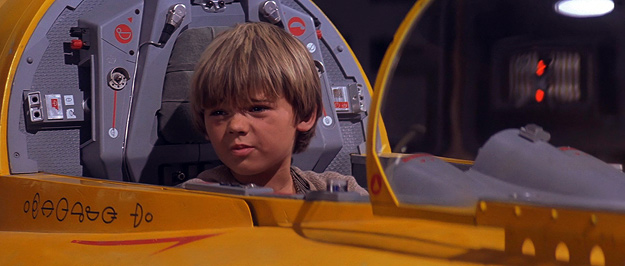
Coate: What are your thoughts on George Lucas returning to direct (as opposed to hiring a different director as he had done on The Empire Strikes Back and Return of the Jedi)?
Danley: I’ve often wondered how things may have turned out had he gone the producer route with another director at the helm. We likely would have ended up with a better film, but it may not have been as compelling a moment in movie history. George’s singular artistic vision and the costs and benefits of having no restraints make The Phantom Menace the fascinating thing it is. It seems that over the years Lucas often referred to Star Wars as his burden to bear. It was his responsibility, for better and for worse.
Miller: No objection. Star Wars is his creation, his property, his vision. Whether his vision is accepted by the public is another matter.
O’Connell: The fact that George Lucas only directed six films in his movie career and that three of them were Star Wars prequels should not be ignored. I always say it was his saga, his project and his efforts. He can choose and creatively appoint whoever he wants. I did feel that maybe Clones and Sith could have followed the original trilogy’s path and cast new directors for the subsequent two films. I would love to have seen Steven Spielberg get his hands on directing one of the prequels. He did admittedly direct some parts of Revenge of the Sith, but I wonder if he might have contained the sprawling politics and scope of the prequels and added a more personal sense of humanity and character that the prequels lacked. But Lucas is famously cautious of Hollywood and navigating its precarious outer rim. Ultimately, it could well have been a safety tactic rather than some obsessional ownership ploy.
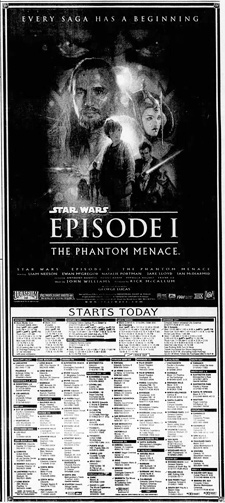 Coate: Where do you think The Phantom Menace ranks among the prequel trilogy? Among the entire saga?
Coate: Where do you think The Phantom Menace ranks among the prequel trilogy? Among the entire saga?
Danley: It absolutely ranks far ahead of Attack of the Clones and Revenge of the Sith for me for a number of reasons. It didn’t fall victim to the technological aspirations of digital cinema the way the second and third films did. Being shot on film with a good number of real locations to ground it, its texture doesn’t cause the discomfort that the other prequels do for me. Speaking of discomfort, the relatively minimal presence of Anakin also works in its favor, as I could never really buy into the way his character was developed and portrayed in the later movies (at least in execution). I’m also quite fond of its sleek, regal aesthetic. As for the rest of the franchise, I really don’t even like trying to rank things that came before or after the original trilogy. Those three will always remain sacred and I prefer to look at the prequels and current films as eras in and of themselves and judge them on their own merits.
Miller: It’s a subjective question. A good way to rank the Star Wars movies is… how many times did you see each one in their original release? In its first year of release, Star Wars was selected by the American Film Institute as one of the ten best American films ever made. Would any other Star Wars film be entitled to be in the Top Ten?
O’Connell: As a Star Wars movie, I once felt that Revenge of the Sith is the only one that truly pushes towards feeling like a proper return to that story world. Yet, I have returned to the prequel trilogy in recent times and now wonder whether — curiously — The Phantom Menace is the stand-out film from that trinity? Maybe it is that Star Wars fever that returned to the minds of ’70s and ’80s kids as the ’90s was pushing into a new millennium? Maybe it was just refreshing to see a film — regardless of its minus points — that knew how to signpost a future story arc without dropping its own story ball. In fairness, not all Marvel films can claim that. Maybe it was the simplicity of that film compared to the narrative hyperbole and complexities of Episode I and Episode II? Maybe it was when you sequence and purvey the first six films in story order that you see an intent of saga, an intent of character and a much stronger story ambition than the naysayers have constantly leveled at that one picture. When 2018’s Solo: A Star Wars Story is willfully making nods and story links to 1999’s entry, it is clear The Phantom Menace was far from a (Jar) jarring failure.
Coate: What is the legacy of The Phantom Menace?
Danley: Much like the original Star Wars and The Force Awakens (to an extent yet to be determined), The Phantom Menace is much more than a film. It caused hysteria unlike anything fandom had ever seen and was a phenomenon that impacted the rules and influenced future trends in the blockbuster industry with regard to visual effects and genre film standards. Though not always implemented successfully in The Phantom Menace, featuring key characters with digital performances and telling a prequel story with an emphasis on world-building are elements that later big-time movies built upon and continue to build upon. It also established a new generation of fans that are deeply passionate about it, which can catch those from the previous generation off-guard. I was recently on a flight to Star Wars Celebration Chicago and happened to be sitting a row behind two fans in their 20s that were meeting each other for the first time. Both shared the opinion that The Phantom Menace was an amazing movie, and that they’d seen it when they were 5 years old and have had an affinity for the prequel era stories ever since. Their enthusiasm was remarkable. And man did I feel old.
Miller: It’s likely to become minimized as Disney churns out more product, focusing less on Lucas’s films and promoting the newer films, TV shows, videogames and toys. Out with the old, in with the new.
The general public also appears to be losing interest in the prequels. The Star Wars films had been popular enough to generate repeat viewings and thus, earn enormous profit. Episode I earned $431.1 million in North America in its initial release in 1999. With a conversion to 3D and release in 2012, it earned $43.5 million domestically. Comparatively speaking, not as many fans wanted to see it in theaters again, or at least in 3D. Plans to release the remaining Star Wars films in 3D were scuttled. (Though a 3D version of Attack of the Clones was screened at Star Wars Celebration Anaheim 2015.)
Seán Schemmel, the voice of adult Goku in the Dragon Ball franchise, had recently turned 50. He admitted at SacAnime 2019, “Sadly, the franchise has completely lost me. I have no interest in it any more. I used to have a Jedi coat on my wall. I was hard core. And it’s gotten so ruined for me. You know what I mean? It just doesn’t — even with the new movies. Look, I love J.J. Abrams… he’s great, but at the same time, I was watching it, going, I don’t think that magic will ever be, in the Star Wars universe, recaptured. And if it does, it will be an amazing feat. I’ve seen all the new movies. They’re good. They just don’t have, for me, that magic.”
O’Connell: It was the first prequel of modern pop culture. Prequels are as old as cinema itself, but this film has become the poster boy for prequels (and the easy abuse leveled at them). Ultimately, its best legacy is that it is the reason we have Star Wars films today. The box-office and fever for The Phantom Menace heralded a new successful trilogy at the box-office. Whether some hate or take issue with it, it was the film that let in a whole garrison of new Star Wars fans. There are as many passionate fans whose entry points were the Pod Race, the Star Wars Lego merchandise, Darth Maul and Duel of the Fates as those that discovered the original series via AT-ATs, Skywalkers, X-Wings and Kenner toys. Do not underestimate the staying power and effect the Pod Race had on young kids’ minds. Many of them have stuck with the series, paid their cinema lobby dollars and created the vital revenue that enables this new era of Star Wars to be unfurling with such a renewed vigor. The business that The Phantom Menace initiated is vital and cannot be kicked into the long Naboo grass by an ailing fan consensus.
Besides, perhaps the film’s greatest legacy has yet to be revealed. The Rise of Skywalker is hinting that not all empirical villainy died with that original trilogy and that the story and character lessons of The Phantom Menace have possibly yet to narratively mature.
Coate: Thank you — Stephen, Bob, and Mark — for sharing your thoughts about Star Wars: Episode I—The Phantom Menace on the occasion of its 20th anniversary.
--END--
IMAGES
Selected images copyright/courtesy Lucasfilm Ltd., Scott Marshall, 20th Century Fox Film Corporation, 20th Century Fox Home Entertainment, The Walt Disney Company.
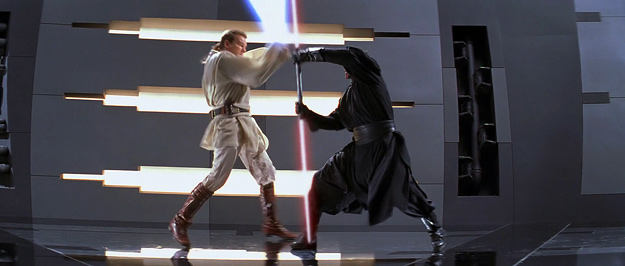
SOURCES/REFERENCES
The primary references for this project were regional newspaper coverage and trade reports published in Billboard, Boxoffice, The Hollywood Reporter and Variety. All figures and data included in this article pertain to the United States and Canada except where stated otherwise.
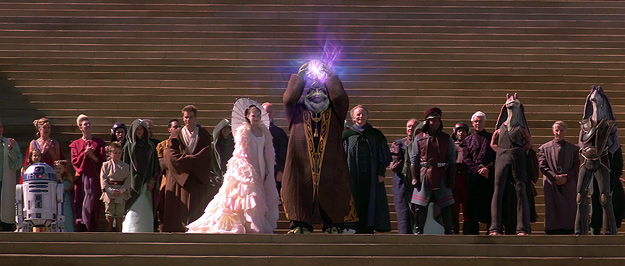
IN MEMORIAM
- Kenny Baker (“R2-D2”), 1934-2016
-Michael Coate
Michael Coate can be reached via e-mail through this link. (You can also follow Michael on social media at these links: Twitter and Facebook)





